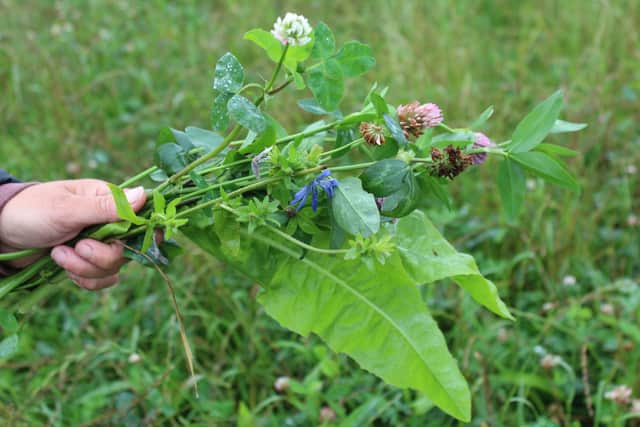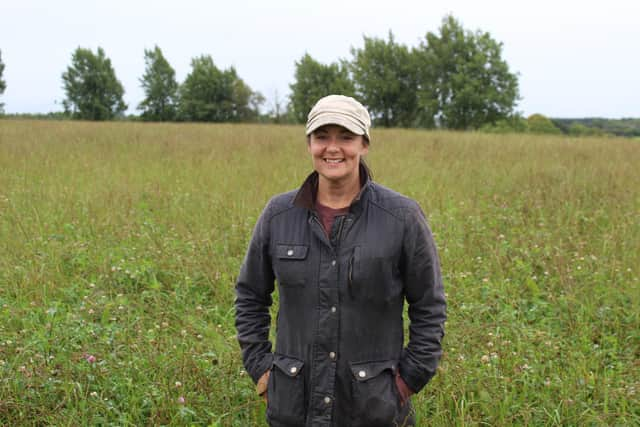Does regenerative agriculture represent the future for farming in Northern Ireland?
and live on Freeview channel 276
The Soil Nutrient Health Scheme is already a reality. But this is only the first of numerous schemes that will allow producers to identify and manage those drivers that will improve their efficiency and sustainability levels over the coming years.
And of course everything will come back to the management of what constitutes a ‘carbon footprint’.
Advertisement
Advertisement
Northern Ireland and the rest of the UK have been set the objective of securing carbon neutrality by 2050.


The legislation is already in place to make this happen.
And according to officials from the Department of Agriculture, Environment and Rural Affairs (DAERA), there can be no rowing back from this target.
Meanwhile, the number of farmers now espousing the values associated with regenerative agriculture continues to grow.
They believe passionately in the role of soil structure and health when it comes to underpinning every aspect of performance and sustainability within their businesses.
Advertisement
Advertisement


In very simple terms, it all comes down to the old ‘three legged stool’ principle.
And in the case of regenerative agriculture, the three principles coming into play are: the physical attributes of soil in tandem with soil chemistry and soil biology.
And in the case of Bronagh O’ Kane, who farms near Cookstown in Co Tyrone, a strong focus has been placed on soil biology.
She came back home to Co Tyrone in late 2018 having previously spent almost 20 years following a number of career options.
Advertisement
Advertisement
This included a 12-year spell as an aircraft engineer in the RAF. Following this, Bronagh had the opportunity of working on one of Scotland’s longest established, pedigree Aberdeen-Angus businesses.
Here, the focus was on developing a high quality beef offering direct to the general public.
Subsequent to this, she was involved in the establishment of a fabric design business.
Bronagh explained.
“I have two brothers: one lives in Australia and the other in Dublin.
Advertisement
Advertisement
"At the end of 2019 my parents announced that they would be heading to Australia.
“The plan was to visit my brother. So that would leave me in charge of the farm in their absence.”
Bronagh’s father and mother – Paddy and Theresa – had previously built up the farm to 150ac.
The focus of the business was a herd of Charolais cross suckler cows, which were traditionally crossed back to a Charolais bull.
Bronagh takes up the story:
Advertisement
Advertisement
“By the time I arrived back home, my father had scaled back the business.
"But this still left me with 90 acres plus a significant number of stock to look after.
“The trip to Australia lasted for three months. But as soon as my parents arrived back, the Covid pandemic hit.
“As my mother suffers from COPD, the decision was taken for my parents to go up to Donegal, where we have a family house.
Advertisement
Advertisement
“As a result, I was left in charge of the farm for a full eight months. However, what started out as a feeling of absolute trepidation turned into one of sheer satisfaction and fulfilment: I knew that I had found my niche in life.”
The O’Kane farm comprises soils that are quite heavy and sticky to the touch.
Particle size is uniformly small at the upper levels of the soil profile.
Bronagh further explained.
“Drainage is quite poor and the soil has a very sticky texture.
Advertisement
Advertisement
"As a result, the ground can be easily poached during periods of wet weather.
“One of the first things I did, after settling on a career in farming, was to go out with a spade and start digging at a number of locations on the farm.
“I quickly found that below the thin top soil was a thick layer of a grey, impervious clay.”
Bronagh knew that it would be impossible to convert a very obvious gley soil to a more free-draining sandy loam with a range of particle sizes.
She added:
Advertisement
Advertisement
“I became fascinated with the subject of soil structure and trawled the internet to find relevant information on this subject.
“After a while it became clear to me that it would be possible to improve the permeability and aggregate quality of the soil. In turn, this would improve the passage of water through it.”
Courtesy of this initial research, Bronagh became aware of the agro-ecologist, Nicole Masters – who had written a book entitled: For the love of Soil.
Her work points to the impact of herbicides, other agrochemicals and chemical fertilisers - over many years - shifting the bacterial: fungal balance of almost all agricultural soils to an extreme position in favour of bacteria.
Advertisement
Advertisement
According to Masters, bacteria help produce the micro-aggregates within soils while fungi encourage trhe fiormation nof macro-aggregates.
“So it became clear that, in my own case, I had to take steps that would encourage the fungal populations within my own soils,” Bronagh continued.
“Making this happen would require the help of earthworms, or to be more specific the material within the casts they produce as part of their digestive metabolism.”
Nicole Masters is a very strong advocate of setting up worm farms because, in her opinion, the vermicast produced by the worms is, possibly, the most effective compost known to man.
Advertisement
Advertisement
So Bronagh set about establishing a worm farm in her own sheds.
She explained:
“Initially, when I went out digging with the spade, I found very few earthworms.
"But I soon found that the composting manure that came from the sheds used for winter bedding the livestock was full of them.”
Vermicompost is the product of the decomposition created by earthworms that are used to inoculate a mixture of bedding materials within a blacked-out environment.
Advertisement
Advertisement
Vermicast levels build up within the material over a period of time, converting the initial heterogeneous materials into a uniform, finely structured compost.
Spreading this material in the most effective manner across all the fields making up the farm was the next challenge confronting Bronagh.
She commented:
“Farmers have become used to spreading large quantities of manures on land in order to generate a growth response.
“But, from a regenerative agriculture perspective we are talking about quite small quantities of fundamentally important soil nutrients.
Advertisement
Advertisement
“However, regenerative agriculture is more about a set of principles, not solely biology.”
Given this backdrop, Bronagh separates her earthworm populations from the vermicompost they produce.
She places small quantities of the compost into a net bag.
This is then suspended into an intermediate bulk container (IBC) with a capacity to hold 1,000L of liquid.
“The water is added and a pond pump put into the container to oxygenate the solution that is created,” she said.
Advertisement
Advertisement
“I also add molasses to the solution. This helps feed the micro organisms that are now in solution.
“It has taken me a while to perfect the growing conditions for the earthworms.
"Simply adding cow dung encourages high levels of bacterial growth. However, if also I add significant amounts of straw and wood chip, this encourages fungal growth.”
The liquor containing the mix of microorganisms is then spread on to the land using a conventional sprayer.
The application rate is 300L/ha.
Advertisement
Advertisement
In 2022 Bronagh managed to get five applications completed across the farm.
This figure dropped to three applications in 2023, a reflection of the poor weather and ground conditions that characterised the entire July/August period.
In order to facilitate the spraying process, Brongah removed all the filters and nozzles on the machine.
“So, in reality, the extract is being dripped on to the soil.
Advertisement
Advertisement
"But the process works and that’s the main thing,” she confirmed.
Bronagh is two years into a project that will, almost certainly, constitute an ongoing commitment for her.
“But the change to the new way of thinking is already delivering positive results,” she confirmed.
Before starting the average pH value of the soils across the farm was 5.6. Within 12 months this figure had risen to 5.8.
Advertisement
Advertisement
“I am convinced that improving soil biology will deliver the improvements that I want to see,” she stressed.
“My primary objective is to secure deeper rooting swards across the farm.
"There is now very clear evidence confirming that water infiltration rates are improving.
“It is now possible to keep cattle out at grass that little bit longer.”
Advertisement
Advertisement
Bronagh is also committed to making best use of the slurries and solid manures produced on the farm.
Making this happen has centred on the production of a lactobacillus-based solution, which is added to both animal bedding and slurry tanks.
The product is made by initially adding water to rice grains.
After three days, the liquor produced is separated off and then mixed with an equal volume of fresh milk.
Advertisement
Advertisement
“The milk is sourced from the cows on the farm,” Bronagh commented.
“After three days, the curd that forms at the top of the solution is removed, leaving the lactobacillus solution ready for use.”
She continued:
“I added the culture to the animal bedding on the farm animal bedding However, of even more significance is the impact generated when the inoculum is added to a slurry tank.
“Within a relatively short period of time, a creamy foam is seen forming on top of the slurry.
Advertisement
Advertisement
“Last year, we found that treated slurry generated no smell at all when spread.
"The lactobacillus solution helps bind ammonia within the slurry with the result that its overall fertiliser value is enhanced while also reducing the smell generated as the product is put out onto the fields.”
Bronagh O’Kane is totally committed to the principles that underpin regenerative farming.
In addition to her work with earthworms and the use of micro organisms to enhance the value of organic manures, she has also committed to the establishment of multispecies swards.
Advertisement
Advertisement
A seven-acre field was sown out with a mix of 15 grass and herb varieties.
All seeds were treated with a coating of vermiculture slurry prior to planting.
According to Bronagh, coating the seeds in this way brings the accompanying biology with it.
She is also in the process of transitioning the suckler herd on the farm from one comprising continental breed types to one within which native cattle breeds predominate.
Advertisement
Advertisement
Bronagh is now using an Aberdeen Angus bull on all her breeding stock.
The adaptive use of a paddock grazing system on the farm has also helped to boost grass utilisation levels.
A small flock of pedigree Charollais sheep also feature on the O’Kane farm.
They are managed in tandem with a group of commercial hoggets.
She concluded:
“In 2020, I found two worms per spade full of soil.
“This year I’m finding between 15 and 25 across the farm.
Advertisement
Advertisement
"This reflects the tremendous improvement in soil health that has been achieved.”
What does regenerative mean in farming?
Regenerative agriculture is an evolution of conventional agriculture, reducing the use of water and other inputs, and preventing land degradation and deforestation. It protects and improves soil, biodiversity, climate resilience and water resources while making farming more productive and profitable.
Regenerative agriculture helps farmers be less reliant on oil and chemicals such as pesticides and artificial fertilisers.